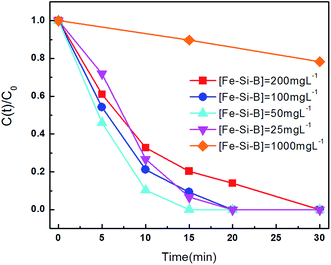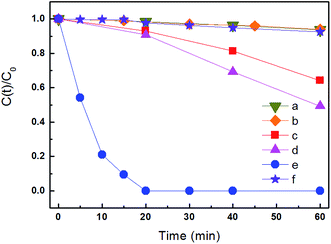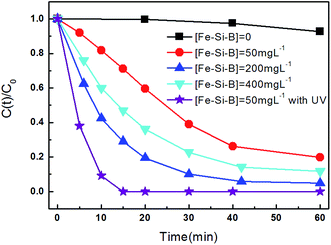Efficient photodecomposition of rhodamine B by an Fe-based metallic glass in an oxalic acid solution
Xingzhou Li,
Ye Pan*,
Jili Wu,
Tao Lu and
Ning Wang
School of Materials Science and Engineering, Jiangsu Key Laboratory for Advanced Metallic Materials, Southeast University, Nanjing 211189, P. R. China. E-mail: panye@seu.edu.cn; Tel: +86-25-52090681
First published on 21st September 2016
Abstract
Fe-based metallic glass (amorphous Fe–Si–B ribbons) was successfully fabricated and shown to be an efficient catalyst of the photo-decomposition of rhodamine B (RhB). The effects of various factors on the photodecomposition were investigated. The catalyst dosage and the wavelength and intensity of the light source were all found to strongly influence the reaction rate. A nearly complete degradation of RhB (20 mg L−1) was achieved within 15 min by 50 mg L−1 Fe–Si–B catalyst and 1 mM oxalic acid when illuminated with 125 W UV light. The Fe–Si–B catalyst was also found to exhibit good structural stability and no loss of performance for three cycles. Based on the results of these experiments, we conclude that the amorphous Fe–Si–B ribbons and oxalic acid constitute a promising heterogeneous Fenton-like system for industrial wastewater treatment.
1. Introduction
During the production of textile dyes, more than 15% of it is lost in wastewater streams, which causes environmental problems.1 It is very important to treat dye waste effluents to lessen its destruction of the environment. Conventional methods to treat dyes include physical adsorption,2 flocculation3 and biological degradation.4 These methods usually do not work efficiently as they are non-destructive and merely involve the transfer of pollutants from water to sludge, and hence result in the production of secondary waste. Thus, there is a need for developing more effective treatment technologies to remove dyes from wastewaters. Recently, advanced oxidation processes (AOPs) such as the Fenton reaction have been found to be very effective at removing organic pollutants from wastewater.5,6 The Fenton system can generate hydroxyl radicals (˙OH), which can in turn degrade most organic pollutants to water and carbon dioxide due to their high oxidation potential (E0 = 2.8 V).5 More recently, ozone, light and electricity have been involved in the Fenton AOP system to increase the efficiency of ˙OH generation. Thus, photo-Fenton and photo-Fenton-like reactions have been extensively used to degrade dyes.7–11 The major drawbacks of the Fenton process are that it operates optimally at a pH of 3 and uses excess amounts of ferrous ions.12,13 To solve these problems, better Fenton-like catalysts need to be developed. On the other hand, H2O2 is added as the direct source of ˙OH in these reactions.14 However, H2O2 is a very reactive compound and does not survive in nature for long. These defects have limited the usefulness of Fenton systems in a natural environment.It is well known that a combination of iron oxides and polycarboxylic acids can form a photochemical system that gives a photo-Fenton-like reaction without the addition of H2O2.15,16 Since there are abundant polycarboxylic acids in the natural environment, this photochemical oxidation process can directly utilize natural materials to decompose organic pollutants economically. It is important to investigate the photodecomposition of dyes in the Fenton systems with polycarboxylic acids and gain a better understanding of how the dyes are transformed. Oxalic acid is one of the most active polycarboxylic acids.17 So in this paper, oxalic acid was selected as both a new ˙OH source and the pH buffer, which provided a proper reaction environment.
Metallic glasses, unlike crystalline metals, are formed by processes involving conditions far from equilibrium, and the constituent atoms do not reside at the thermodynamic equilibrium positions.18,19 This metastable nature imparts many excellent properties onto amorphous alloys that are unachievable for crystalline alloys, such as good catalytic and chemical properties.20,21 Meanwhile, Fe-based metallic glasses have been widely studied due to their low cost, good resistance to corrosion, and excellent soft magnetic properties.20 Therefore, there is great potential for using Fe-based metallic glasses as a Fenton-like catalyst to degrade dyes.
In this work, amorphous Fe78Si9B13 ribbons were prepared by applying the melt-spinning technique and were used as catalysts. The catalytic performance of the Fe–Si–B amorphous ribbons was investigated for the degradation of rhodamine B (RhB), which was used as a model pollutant. RhB, one of the important xanthene dyes, has become a common organic pollutant and exhibits quite high resistance to photodegradation and oxidative degradation.22 The major objectives of this work were (i) to develop a new Fenton system combining amorphous Fe–Si–B alloys and oxalic acid; (ii) to evaluate the degradation performance of the new Fenton system for RhB; and (iii) to investigate the influences of various reaction parameters on the rate of degradation. We also discuss the RhB degradation mechanism and the stability of amorphous Fe–Si–B ribbons.
2. Materials and methods
2.1 Materials
RhB (>99%) was purchased from Tianjin Chemical Reagent Research Institute, China. Oxalic acid was purchased from Sinopharm Chemical Reagent Co., Ltd, China. All of the chemicals were of analytical grade and were used as received without further purification. Deionized water was used for preparing the RhB solutions in the experiments.2.2 Preparation and characterization of amorphous Fe–Si–B ribbons
The master ingot of Fe78Si9B13 was produced by arc melting a mixture of Fe, Si, and B (each with a purity greater than 99%) under a Ti-gettered argon atmosphere. The ingot was then remelted in a quartz tube by carrying out induction melting, followed by single roller spinning to obtain the amorphous ribbons. The ribbons were 2 mm in width and 20 μm in thickness.The crystal structures of the catalysts were determined by performing X-ray diffraction (XRD). The XRD data were collected on a D8 Bruker diffractometer with Cu Kα radiation.
2.3 Procedure and approach
Unless indicated otherwise, the reaction mixture was formed by adding various amounts of an Fe-based amorphous alloy and oxalic acid to 100 mL samples of an aqueous solution containing 20 mg L−1 of RhB. Before the photoreaction, the mixture was magnetically stirred in the dark for 0.5 h to establish an adsorption–desorption equilibrium. The various mixtures were then illuminated with ultraviolet (UV) or visible radiation while being magnetically stirred. The UV reactions were conducted with a 300 W mercury lamp and a 125 W mercury lamp, respectively, to study the effect of UV intensity on the reactions. The reaction with visible light was achieved by using a 350 W xenon lamp. At given time intervals, 3 mL aliquots were collected and then centrifuged, and the resulting supernatant was analyzed by using UV-Vis spectroscopy. The UV-Vis absorption spectra of the aqueous solutions were recorded from 200 to 800 nm using a UV-Vis spectrophotometer (TU1800-PC, Beijing). The RhB concentration was determined based on the constructed calibration curve at the maximum absorption wavelength (λmax) of 554 nm. Moreover, (Fe3+, Fe2+) concentrations in the solution after the reaction were determined by carrying out inductively coupled plasma emission spectrometry (ICP) using a SPECTROBLUE ICP-OES (Spectro, Inc.).3. Results and discussion
3.1 Characterization of the Fe–Si–B catalyst
The XRD pattern of the Fe78Si9B13 ribbons obtained by the melt-spinning technique is shown in Fig. 1. The XRD pattern of Fe is also included in Fig. 1 for comparison. In addition, the XRD pattern of the Fe78Si9B13 ribbon after being irradiated with UV light for 3 cycles in the presence of 1 mM oxalic acid is also shown in Fig. 1. The amorphous nature of the as-received ribbon was indicated by the broadness of the peak in the XRD pattern. The results demonstrated that the ribbon displayed only short-range order, and the zero-valent iron (ZVI) in the ribbon was successfully frozen into an amorphous state. Meanwhile, the amorphous nature of the Fe–Si–B ribbon was maintained after being used for the degradation of RhB.3.2 Photodecomposition of RhB
There have been few studies about the combination of ZVI and oxalic acid. On the other hand, the photochemistry of Fe(III)–oxalate complexes has been studied by many workers.24–26 So the degradation mechanism of Fe(III)–oxalate complexes could be a reference for the new photo-Fenton system. According to this extrapolated mechanism, during the photochemical reaction of ZVI and oxalic acid under UV illumination, superoxides (˙O2−) and hydroperoxyl radicals (˙O2H) (eqn (2)–(5)) would have formed as the key intermediates. H2O2, formed from ˙O2− and ˙O2H, (eqn (6) and (7)) would have then taken part in a Fenton reaction to produce ˙OH (eqn (8)):
| ZVI + nH2C2O4 + hν → [Fe(III)(C2O4)n](2n−3)− + H2 | (1) |
| [Fe(III)(C2O4)n](2n−3)− + hν → [Fe(II)(C2O4)(n−1)](4−2n) + ˙(C2O4)− | (2) |
| ˙(C2O4)− → CO2 + ˙(CO2)− | (3) |
| ˙(CO2)− + O2 → CO2 + ˙O2− | (4) |
| ˙O2− + H+ → ˙O2H | (5) |
| ˙O2− + Fe3+ → Fe2+ + O2 | (6) |
| ˙O2−/˙O2H− + nH+ + Fe2+ → Fe3+ + H2O2 | (7) |
| Fe2+ + H2O2 → Fe3+ + OH− + ˙OH | (8) |
Oxalic acid would have first adsorbed on the surface of the ribbons in the presence of UV radiation to form [Fe(III)(C2O4)n](2n−3)− (eqn (1)). This complex could have been excited under illumination to form [Fe(II)(C2O4)(n−1)](4−2n) and the oxalate radical ˙(C2O4)− (eqn (2)). The oxalate radical would have then transformed to the carbon-centered radical ˙(CO2)− (eqn (3)),27 and the excited electrons would have transferred to the adsorbed oxygen to form superoxide ions ˙(O2)− (eqn (4)). Fe(III) would have reacted with ˙(O2)− to form O2 and Fe(II), and Fe(II) would have reacted with ˙O2− and ˙O2H to form H2O2 in acidic solution with Fe(III) (eqn (6) and (7)).28 After the formation of H2O2, hydroxyl radicals could have been generated by the reaction of Fe(II) and H2O2 as described in eqn (8). Meanwhile, there was no significant leaching of Fe ions. The concentration of leached Fe (Fe2+, Fe3+) in the solution was 0.1 mg L−1, which was comparable to the results obtained by Zheng29 (2 mg L−1) and Zhang30 (0.18 mg L−1). This result indicated that all of the reactions occurred on the ribbon surface.
 | ||
| Fig. 3 Effect of Fe–Si–B ribbon concentration on the degradation of RhB with 2 mM oxalic acid and UV (125 W mercury lamp). | ||
We attributed this phenomenon to the amount of Fe ions taking part in the reaction. Since this type of photoreaction proceeds by the generation of Fe(III)–oxalate complexes, the presence of Fe ions was essential. The concentration of Fe ions of course increased with increasing Fe–Si–B concentration. Thus, the formation of [Fe(III)(C2O4)n](3−2n)−, which has been shown to have high photoactivity under UV illumination,31 appears to have occurred in sufficient quantity at an appropriate Fe ion concentration. Hence more ˙OH radicals were apparently produced during the photochemical reaction in the present Fe–Si–B ribbon-oxalate system. A lower concentration of Fe ions (25 mg L−1) led to less photodecomposition of RhB due to the formation of less [Fe(III)(C2O4)n](3−2n)−. On the other hand, too high an Fe ion concentration (100 mg L−1 to 1000 mg L−1) also led to lower photodecomposition of RhB. Such a high concentration of Fe ions would have promoted scavenging reactions (eqn. (9) and (10)),32 and hence decrease the concentration of hydroxyl radicals involved in degradation.
| Fe2+ + ˙O2H → Fe3+ + HO2− | (9) |
| Fe2+ + ˙OH → Fe3+ + HO− | (10) |
The effect of the UV illumination intensity was also examined. Fig. 6 shows the degradation of RhB with a 300 W mercury lamp light source. For a given concentration of the amorphous Fe–Si–B ribbons, increasing the illumination intensity was expected to yield more Fe ions. For the 125 W mercury lamp, 50 mg L−1 of Fe–Si–B was determined to be optimum. However, at this Fe–Si–B concentration, increasing the power of the mercury lamp to 300 W would have produced more Fe ions, and hence exceeded the optimum concentration of Fe ions. And indeed, the degradation rate was observed to decrease. Moreover, as the power of the mercury lamp was increased to 300 W, the optimum Fe–Si–B dosage decreased to 25 mg L−1, which is consistent with the interpretation above. The best degradation rate for the 300 W mercury lamp was lower than that for the 125 W mercury lamp due to the lower Fe–Si–B concentration, which led to a smaller reaction area.
4. Conclusions
The photodecomposition behavior of RhB was investigated using amorphous Fe–Si–B ribbons in an oxalate solution, and illuminated with UV and visible radiation. The following results were obtained.(1) A new Fenton system including amorphous Fe-based ribbons and oxalic acid was developed. The combination of amorphous Fe–Si–B ribbons, oxalic acid and light illumination was essential for the photodecomposition of RhB.
(2) The new Fenton system showed a considerable ability to effect degradation. A nearly complete degradation of RhB (20 mg L−1) was achieved within 15 min by the use of 50 mg L−1 Fe–Si–B catalyst and 1 mM oxalic acid when illuminated by 125 W UV light.
(3) The Fe–Si–B concentration was found to be an important parameter. An optimum Fe-based ribbon concentration was found to be associated with each experimental condition. In particular, when the intensity of the light source was increased, the optimum dosage of the Fe–Si–B decreased.
(4) The amorphous Fe–Si–B ribbon functioned as a catalyst in the Fenton system. It has great long-term stability and excellent potential application value due to the ease with which it can be easily separated from the reaction solution.
Acknowledgements
The authors acknowledge financial support from the National Natural Science Foundation of China (Grant no. 51671056) and the Jiangsu key laboratory for advanced metallic materials (BM2007204).References
- H. Park and W. Choi, J. Photochem. Photobiol., A, 2003, 159, 241–247 CrossRef CAS.
- M. Law, L. E. Greene, J. C. Johnson, R. Saykally and P. D. Yang, Nat. Mater., 2005, 4, 455–459 CrossRef CAS PubMed.
- V. Golob, A. Vinder and M. Simonic, Dyes Pigm., 2005, 67, 93–97 CrossRef CAS.
- A. B. dos Santos, F. J. Cervantes and J. B. van Lier, Bioresour. Technol., 2007, 98, 2369–2385 CrossRef CAS PubMed.
- J. Herney-Ramirez, M. A. Vicente and L. M. Madeira, Appl. Catal., B, 2010, 98, 10–26 CrossRef CAS.
- M.-F. Hou, L. Liao, W.-D. Zhang, X.-Y. Tang, H.-F. Wan and G.-C. Yin, Chemosphere, 2011, 83, 1279–1283 CrossRef CAS PubMed.
- J. E. F. Moraes, F. H. Quina, C. A. O. Nascimento, D. N. Silva and O. Chiavone, Environ. Sci. Technol., 2004, 38, 1183–1187 CrossRef CAS PubMed.
- W. Z. Tang and R. Z. Chen, Chemosphere, 1996, 32, 947–958 CrossRef CAS.
- J. Kiwi, N. Denisov, Y. Gak, N. Ovanesyan, P. A. Buffat, E. Suvorova, F. Gostev, A. Titov, O. Sarkisov, P. Albers and V. Nadtochenko, Langmuir, 2002, 18, 9054–9066 CrossRef CAS.
- X. Tao, J. M. Su, J. F. Chen and J. C. Zhao, Chem. Commun., 2005, 4607–4609 RSC.
- J. Bandara and J. Kiwi, New J. Chem., 1999, 23, 717–724 RSC.
- Z. H. Ai, L. R. Lu, J. P. Li, L. Z. Zhang, J. R. Qiu and M. H. Wu, J. Phys. Chem. C, 2007, 111, 4087–4093 CAS.
- J. Poerschmann, U. Trommler, T. Gorecki and F. D. Kopinke, Chemosphere, 2009, 75, 772–780 CrossRef CAS PubMed.
- M. Pera-Titus, V. Garcia-Molina, M. A. Banos, J. Gimenez and S. Esplugas, Appl. Catal., B, 2004, 47, 219–256 CrossRef CAS.
- C. Siffert and B. Sulzberger, Langmuir, 1991, 7, 1627–1634 CrossRef CAS.
- B. C. Faust and R. G. Zepp, Environ. Sci. Technol., 1993, 27, 2517–2522 CrossRef CAS.
- F. B. Li, J. J. Chen, C. S. Liu, J. Dong and T. X. Liu, Biol. Fertil. Soils, 2006, 42, 409–417 CrossRef CAS.
- A. L. Greer, Science, 1995, 267, 1947–1953 CAS.
- A. Inoue, Acta Mater., 2000, 48, 279–306 CrossRef CAS.
- B. Lin, X. F. Bian, P. Wang and G. P. Luo, Mater. Sci. Eng., B, 2012, 177, 92–95 CrossRef CAS.
- J. Q. Wang, Y. H. Liu, M. W. Chen, G. Q. Xie, D. V. Louzguine-Luzgin, A. Inoue and J. H. Perepezko, Adv. Funct. Mater., 2012, 22, 2567–2570 CrossRef CAS.
- J. C. Yan, H. Q. Tang, Z. F. Lin, M. N. Anjum and L. H. Zhu, Chemosphere, 2012, 87, 111–117 CrossRef CAS PubMed.
- H. Lee, H.-J. Lee, H.-E. Kim, J. Kweon, B.-D. Lee and C. Lee, J. Hazard. Mater., 2014, 265, 201–207 CrossRef CAS PubMed.
- Y. G. Zuo and Y. W. Deng, Chemosphere, 1997, 35, 2051–2058 CrossRef CAS.
- M. E. Balmer and B. Sulzberger, Environ. Sci. Technol., 1999, 33, 2418–2424 CrossRef CAS.
- R. W. Sloper, P. S. Braterman, A. G. Cairnssmith, T. G. Truscott and M. Craw, J. Chem. Soc., Chem. Commun., 1983, 488–489 RSC.
- Y. Chen, F. Wu, Y. Lin, N. Deng, N. Bazhin and E. Glebov, J. Hazard. Mater., 2007, 148, 360–365 CrossRef CAS PubMed.
- J. H. Ma, W. H. Ma, W. J. Song, C. C. Chen, Y. L. Tang, J. C. Zhao, Y. P. Huang, Y. M. Xu and L. Zang, Environ. Sci. Technol., 2006, 40, 618–624 CrossRef CAS PubMed.
- P. Zheng, B. Bai, W. S. Guan, H. L. Wang and Y. R. Suo, RSC Adv., 2016, 6, 4101–4107 RSC.
- J. J. Zhang, X. H. Zhang and Y. F. Wang, RSC Adv., 2016, 6, 13168–13176 RSC.
- X. Wang, C. Liu, X. Li, F. Li and S. Zhou, J. Hazard. Mater., 2008, 153, 426–433 CrossRef CAS PubMed.
- C. Walling, Acc. Chem. Res., 1975, 8, 125–131 CrossRef CAS.
| This journal is © The Royal Society of Chemistry 2016 |






